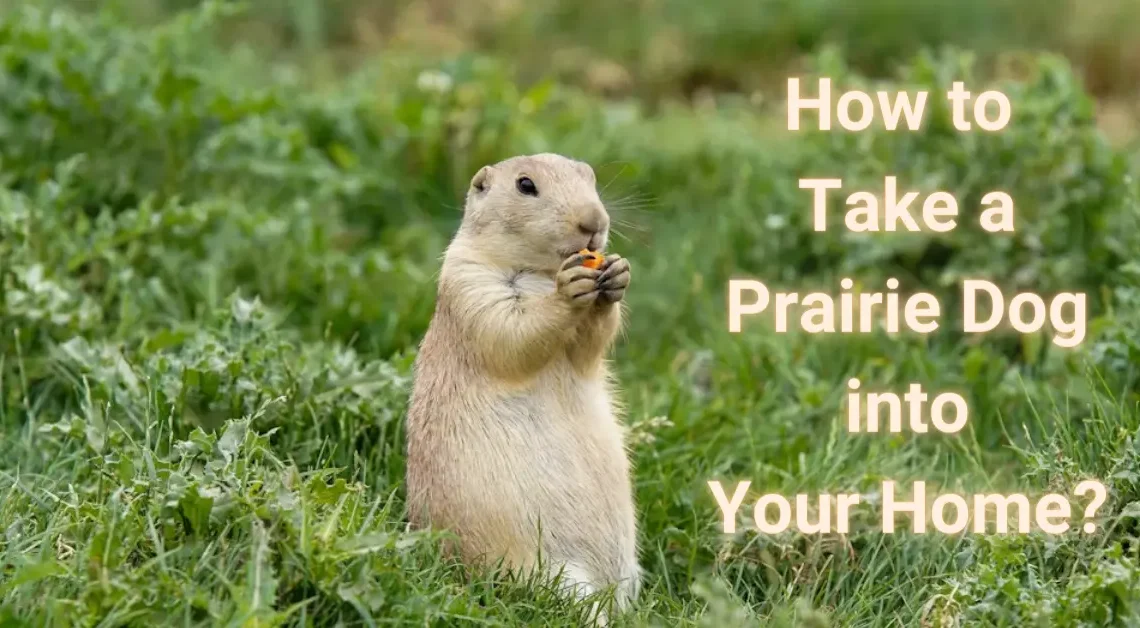
How to Adopt a Prairie Dog? A Comprehensive Guide
Considering adopting a prairie dog? These furry critters, especially black-tailed ones, are gaining popularity as pets. But before you take the leap, it’s essential to understand what it entails. Prairie dogs are sociable creatures, preferring the company of their own kind. This means you might need to consider getting more than one.Males and females have different housing needs, and if you’re planning to keep them together, spaying or neutering is a must to avoid unexpected baby prairie dogs! Additionally, prairie dogs require a specific diet and plenty of space for burrowing. Dental issues and obesity are common health concerns, so regular vet check-ups are vital. Now that you know a bit more about how to adopt a prairie dog, let’s delve deeper into the process and what it entails.
Understanding Prairie Dogs: Key to Successful Adoption
Before delving into the process of how to adopt a prairie dog, it’s essential to grasp some fundamental aspects of these intriguing creatures. Prairie dogs, particularly black-tailed prairie dogs, are becoming popular as pets. However, to ensure a successful adoption and provide the best care possible, it’s crucial to understand their behavior and needs.
Social Nature
In the wild, prairie dogs are highly social animals that live in groups known as colonies or towns. They spend a lot of time interacting with each other, communicating through various vocalizations and body language. This social aspect is essential to their well-being and happiness. Therefore, when considering adopting a prairie dog, it’s important to understand that they thrive in companionship and may not do well if kept alone.
Group Living
Because of their social nature, prairie dogs prefer to live in pairs or small groups. Adopting multiple prairie dogs can help prevent loneliness and provide them with the social interaction they need. When adopting, consider getting a pair or more if possible, to ensure the well-being and happiness of your new pets.
Behavioral Traits
Prairie dogs exhibit fascinating behaviors, such as greeting each other with a sort of “kiss” and communicating through barks and chirps. Understanding these behaviors can help you better care for and bond with your pet. When adopting a prairie dog, observe their behavior and try to provide an environment that allows for natural behaviors, such as burrowing and socializing.
Importance for Adoption
Understanding the social nature and behavior of prairie dogs is crucial for a successful adoption. It enables you to provide the necessary companionship, environment, and care to ensure the well-being and happiness of your new pet. By adopting multiple prairie dogs and creating a suitable living environment, you can give them a fulfilling and enriching life as part of your family.
Males vs. Females: Understanding Your Options When Adopting a Prairie Dog
When considering how to adopt a prairie dog, understanding the differences between males and females is essential. This knowledge helps you make informed decisions about housing, breeding, and overall care for your new pet.
Males
Males can be housed together if neutered. Neutering prevents them from mating and producing offspring. This is crucial if you don’t want surprise litters of baby prairie dogs! Neutered males can live harmoniously with other neutered males or with females. They tend to be larger in size compared to females.
Females
Females can be housed together with or without spaying. Spaying prevents them from becoming pregnant. If you choose to house males and females together, it’s essential to neuter the males to avoid unplanned pregnancies. Female prairie dogs usually give birth to one litter of pups per year, so controlling breeding is important unless you’re prepared for the responsibility of caring for and finding homes for the babies.
Understanding the differences between males and females can help you decide what type of prairie dog or combination of prairie dogs is right for you.
Reproduction and Health: What You Need to Know Before Adopting a Prairie Dog
When thinking about how to adopt a prairie dog, it’s crucial to understand their reproductive patterns and health needs. Female prairie dogs typically have one litter of pups per year. This means if you adopt a female, you might have baby prairie dogs to care for eventually. Each litter can have anywhere from 2 to 10 pups, so be prepared for a potential increase in your furry family.
To ensure the health of your prairie dog, it’s important to provide a balanced diet and regular exercise. Prairie dogs, like humans, can suffer from dental issues and obesity if not properly cared for. A diet rich in fiber, such as Timothy hay or Orchard grass, can help prevent these problems. Additionally, regular veterinary check-ups are essential to catch any health issues early on.
Understanding the reproductive and health needs of prairie dogs is essential for anyone considering adopting one.
Selecting Your Pet Prairie Dog
When it comes to adopting a prairie dog, choosing the right one is crucial for a happy and healthy relationship. Here’s a simple guide on how to pick the perfect prairie dog for you.
1. Look for Young and Healthy Prairie Dogs
It’s best to adopt a young prairie dog as they are more adaptable to new environments and tend to bond better with their owners. Make sure the prairie dog you choose is healthy, with clear eyes and nose, and shows no signs of illness or parasites.
2. Check for Alertness and Curiosity
A good prairie dog should be alert, curious, and interested in its surroundings. Avoid selecting a prairie dog that seems lethargic or uninterested, as this could indicate underlying health issues.
3. Handleability:
When handling potential prairie dog candidates, pay attention to how they react. They should be comfortable with being picked up and handled gently. Avoid prairie dogs that show signs of aggression or fearfulness.
4. Physical Appearance
Inspect the prairie dog’s body for any signs of injury or abnormalities. Ensure they are of a healthy weight and have a shiny coat. Check for any discharge around the eyes, nose, or anus, as these could be indicators of health problems.
5. Veterinary Check-Up
Before finalizing the adoption, schedule a veterinary check-up within 48 hours of bringing your prairie dog home. This is essential to ensure they are in good health and to discuss their care needs with a qualified veterinarian.
By following these simple steps, you can ensure that you adopt a prairie dog that will bring joy and companionship into your life. Remember, adopting a prairie dog is a long-term commitment, so take your time and choose wisely.
Housing and Care for Your Prairie Dog

When you’re considering how to adopt a prairie dog, one of the most crucial aspects is setting up the right living environment and ensuring proper care. Prairie dogs are active creatures that need space to move around and express their natural behaviors.
Choosing the Right Home
Your prairie dog’s home should mimic its natural habitat as closely as possible. This means providing a spacious enclosure with plenty of room for burrowing. A large cage with multiple levels or platforms can help satisfy their need for exploration and exercise.
Creating a Burrowing Environment
Prairie dogs love to dig, so make sure their enclosure has plenty of substrate, such as hay or shredded paper, for them to burrow in. You can also add tunnels and hideouts to encourage their natural digging behavior.
Regular Veterinary Care
Just like any other pet, prairie dogs need regular veterinary check-ups to ensure they stay healthy. Your veterinarian can provide guidance on proper diet, housing, and preventive care measures. They can also address any health concerns that may arise.
Socialization and Interaction
Prairie dogs are social animals that thrive on interaction with their human caregivers. Spending time with your prairie dog each day, whether it’s playing, grooming, or simply sitting together, can help strengthen your bond and keep them mentally stimulated.
Preparing for Adoption: Getting Ready to Bring Your Prairie Dog Home
Before you make the exciting decision to adopt a prairie dog, it’s crucial to take some important steps to ensure you’re fully prepared for the responsibility ahead. Here’s what you need to do to get ready for your new furry friend:
Research and Education: Before diving into adoption, take the time to learn all you can about prairie dogs. Understand their behavior, dietary needs, housing requirements, and potential health issues. This knowledge will help you provide the best possible care for your new pet.
Check Local Laws: Make sure to check the exotic pet laws in your area to ensure that owning a prairie dog is legal. Some places may have restrictions or require permits for keeping exotic pets.
Assess Your Ability to Provide Care: Consider your lifestyle and whether you have the time, resources, and commitment to care for a prairie dog properly. These animals require daily interaction, a suitable habitat, and regular veterinary care.
Create a Safe Environment: Prepare a suitable habitat for your prairie dog before bringing them home. This includes a spacious cage or enclosure with plenty of room for burrowing and exploring. Remove any hazards from your home, such as electrical cords or toxic substances, to keep your prairie dog safe.
Find a Reputable Breeder or Rescue: Research breeders or rescue organizations in your area that specialize in prairie dogs. Look for reputable sources that prioritize the health and well-being of their animals.
Consider Adoption: Many prairie dogs are in need of loving homes through rescue organizations or animal shelters. Consider adopting instead of purchasing from a breeder to give a deserving animal a second chance.
Plan for Long-Term Care: Remember that adopting a prairie dog is a long-term commitment. Be prepared to provide care for your pet for their entire lifespan, which can be up to 10 years or more.
Conclusion
Adopting a prairie dog is a big responsibility, but it can also be incredibly rewarding. By following the tips on how to adopt a prairie dog and understanding their needs, you can provide a loving home for these unique pets. Remember to consider their social nature, dietary requirements, and potential health issues before bringing one home. Providing a spacious enclosure with opportunities for burrowing, a balanced diet rich in fiber, and regular veterinary check-ups are essential for their well-being. If you’re prepared to make the commitment, adopting a prairie dog can bring joy and companionship to your life. So, take the time to learn about these fascinating creatures and ensure you’re ready to provide the care and attention they deserve.
You may be interested in reading:


